EDE3103 Assignment 1: Early Years Curriculum, Play, and Pedagogy
VerifiedAdded on 2022/10/09
|15
|4257
|37
Project
AI Summary
This assignment presents a parent presentation script focused on the importance of play in early childhood education. It addresses parental concerns about school preparation and advocates for play as a crucial element in a child's overall development. The script highlights how play fosters empathy, social skills, cognitive learning, and critical thinking, which are essential for a well-adjusted person. The presentation emphasizes the value of both structured and unstructured play, countering the argument that play is a waste of time and highlighting its role in promoting physical and mental health. The assignment also discusses the significance of the early years, the role of preschool educators in facilitating a smooth transition to school, and the importance of cultural diversity and inclusive practices. It stresses the need for educators to design programs that are learner-centric and provide equal opportunities for all children. The assignment references various studies and theories to support its arguments, including the United Nation High Commission for Human Rights, Vygotsky's theory, and the scaffolding theory. The presentation aims to educate parents about the benefits of play-based learning and encourage them to participate in their children's development. It underscores the importance of teachers, school management, and the community working together to support children's learning and well-being.
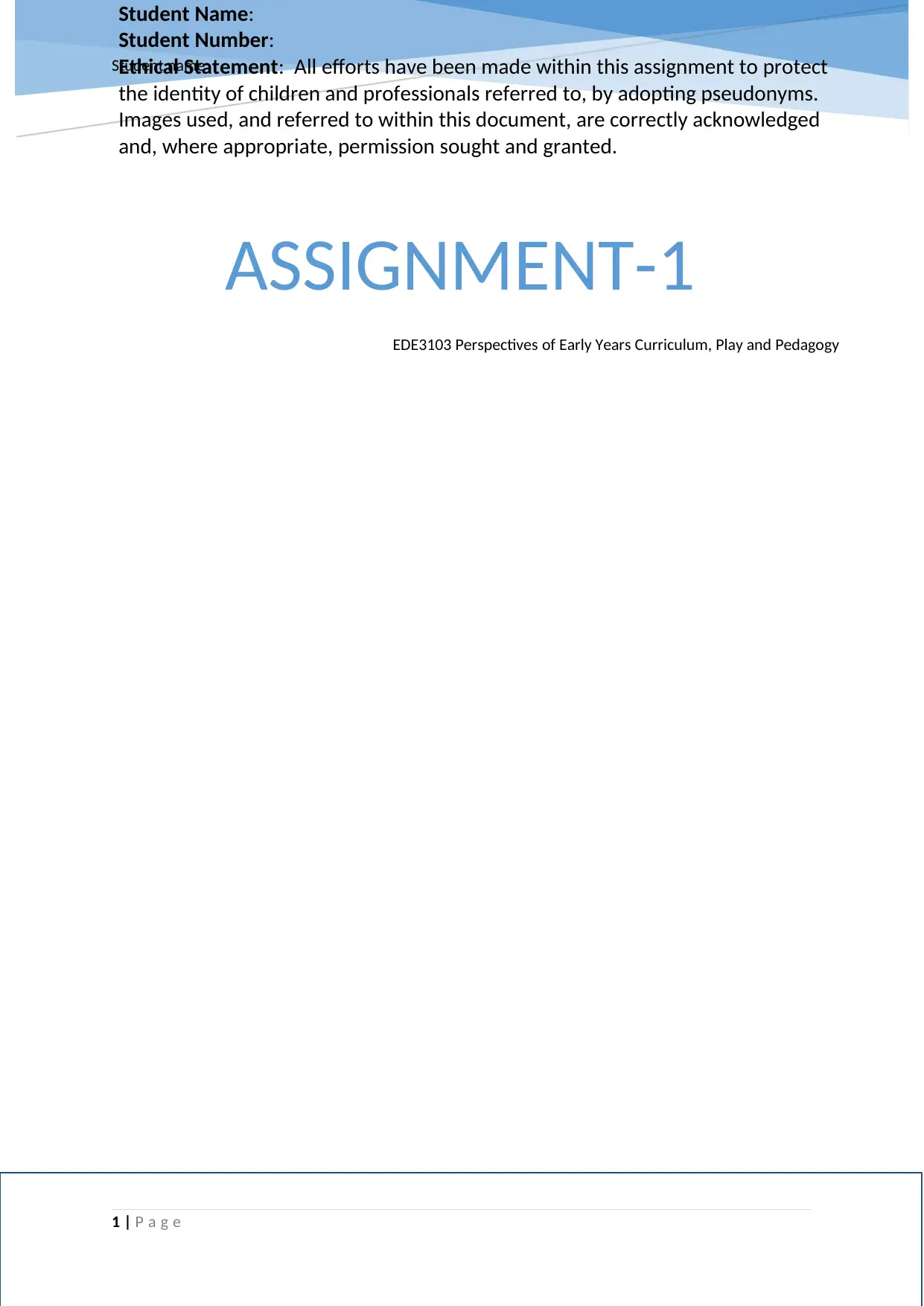
ASSIGNMENT-1
EDE3103 Perspectives of Early Years Curriculum, Play and Pedagogy
Student name
1 | P a g e
Student Name:
Student Number:
Ethical Statement: All efforts have been made within this assignment to protect
the identity of children and professionals referred to, by adopting pseudonyms.
Images used, and referred to within this document, are correctly acknowledged
and, where appropriate, permission sought and granted.
EDE3103 Perspectives of Early Years Curriculum, Play and Pedagogy
Student name
1 | P a g e
Student Name:
Student Number:
Ethical Statement: All efforts have been made within this assignment to protect
the identity of children and professionals referred to, by adopting pseudonyms.
Images used, and referred to within this document, are correctly acknowledged
and, where appropriate, permission sought and granted.
Paraphrase This Document
Need a fresh take? Get an instant paraphrase of this document with our AI Paraphraser
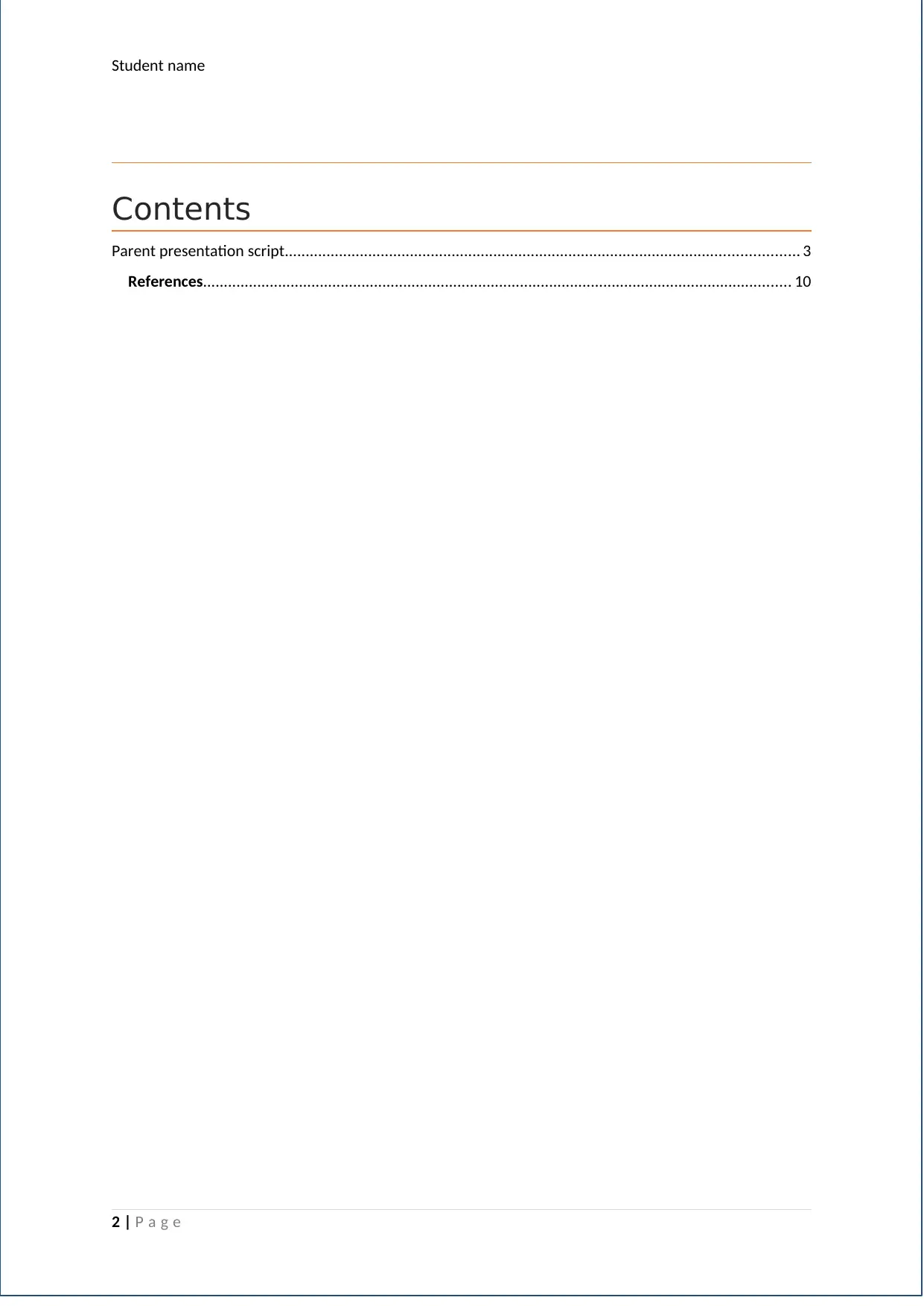
Student name
Contents
Parent presentation script........................................................................................................................... 3
References............................................................................................................................................. 10
2 | P a g e
Contents
Parent presentation script........................................................................................................................... 3
References............................................................................................................................................. 10
2 | P a g e
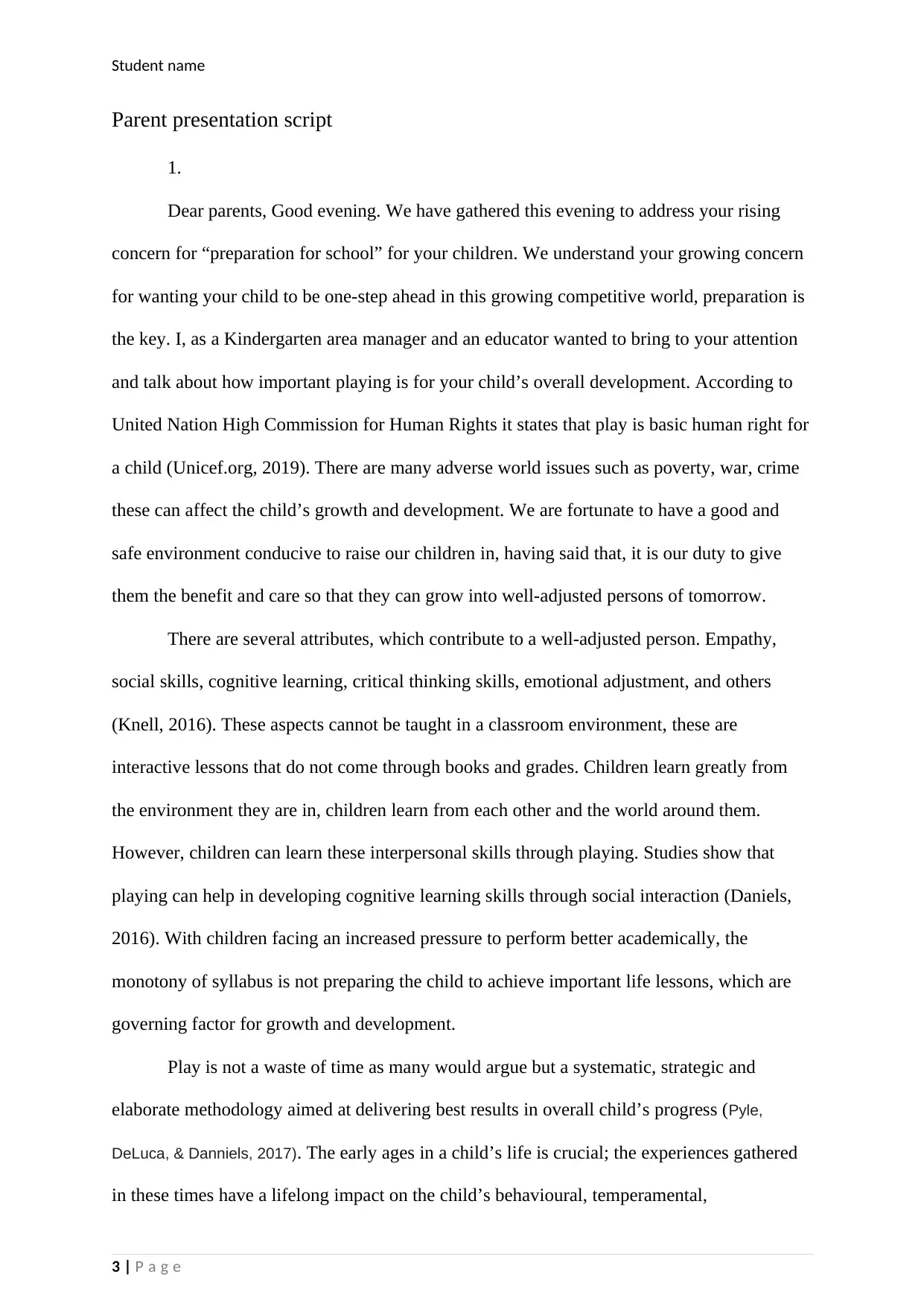
Student name
Parent presentation script
1.
Dear parents, Good evening. We have gathered this evening to address your rising
concern for “preparation for school” for your children. We understand your growing concern
for wanting your child to be one-step ahead in this growing competitive world, preparation is
the key. I, as a Kindergarten area manager and an educator wanted to bring to your attention
and talk about how important playing is for your child’s overall development. According to
United Nation High Commission for Human Rights it states that play is basic human right for
a child (Unicef.org, 2019). There are many adverse world issues such as poverty, war, crime
these can affect the child’s growth and development. We are fortunate to have a good and
safe environment conducive to raise our children in, having said that, it is our duty to give
them the benefit and care so that they can grow into well-adjusted persons of tomorrow.
There are several attributes, which contribute to a well-adjusted person. Empathy,
social skills, cognitive learning, critical thinking skills, emotional adjustment, and others
(Knell, 2016). These aspects cannot be taught in a classroom environment, these are
interactive lessons that do not come through books and grades. Children learn greatly from
the environment they are in, children learn from each other and the world around them.
However, children can learn these interpersonal skills through playing. Studies show that
playing can help in developing cognitive learning skills through social interaction (Daniels,
2016). With children facing an increased pressure to perform better academically, the
monotony of syllabus is not preparing the child to achieve important life lessons, which are
governing factor for growth and development.
Play is not a waste of time as many would argue but a systematic, strategic and
elaborate methodology aimed at delivering best results in overall child’s progress (Pyle,
DeLuca, & Danniels, 2017). The early ages in a child’s life is crucial; the experiences gathered
in these times have a lifelong impact on the child’s behavioural, temperamental,
3 | P a g e
Parent presentation script
1.
Dear parents, Good evening. We have gathered this evening to address your rising
concern for “preparation for school” for your children. We understand your growing concern
for wanting your child to be one-step ahead in this growing competitive world, preparation is
the key. I, as a Kindergarten area manager and an educator wanted to bring to your attention
and talk about how important playing is for your child’s overall development. According to
United Nation High Commission for Human Rights it states that play is basic human right for
a child (Unicef.org, 2019). There are many adverse world issues such as poverty, war, crime
these can affect the child’s growth and development. We are fortunate to have a good and
safe environment conducive to raise our children in, having said that, it is our duty to give
them the benefit and care so that they can grow into well-adjusted persons of tomorrow.
There are several attributes, which contribute to a well-adjusted person. Empathy,
social skills, cognitive learning, critical thinking skills, emotional adjustment, and others
(Knell, 2016). These aspects cannot be taught in a classroom environment, these are
interactive lessons that do not come through books and grades. Children learn greatly from
the environment they are in, children learn from each other and the world around them.
However, children can learn these interpersonal skills through playing. Studies show that
playing can help in developing cognitive learning skills through social interaction (Daniels,
2016). With children facing an increased pressure to perform better academically, the
monotony of syllabus is not preparing the child to achieve important life lessons, which are
governing factor for growth and development.
Play is not a waste of time as many would argue but a systematic, strategic and
elaborate methodology aimed at delivering best results in overall child’s progress (Pyle,
DeLuca, & Danniels, 2017). The early ages in a child’s life is crucial; the experiences gathered
in these times have a lifelong impact on the child’s behavioural, temperamental,
3 | P a g e
⊘ This is a preview!⊘
Do you want full access?
Subscribe today to unlock all pages.

Trusted by 1+ million students worldwide
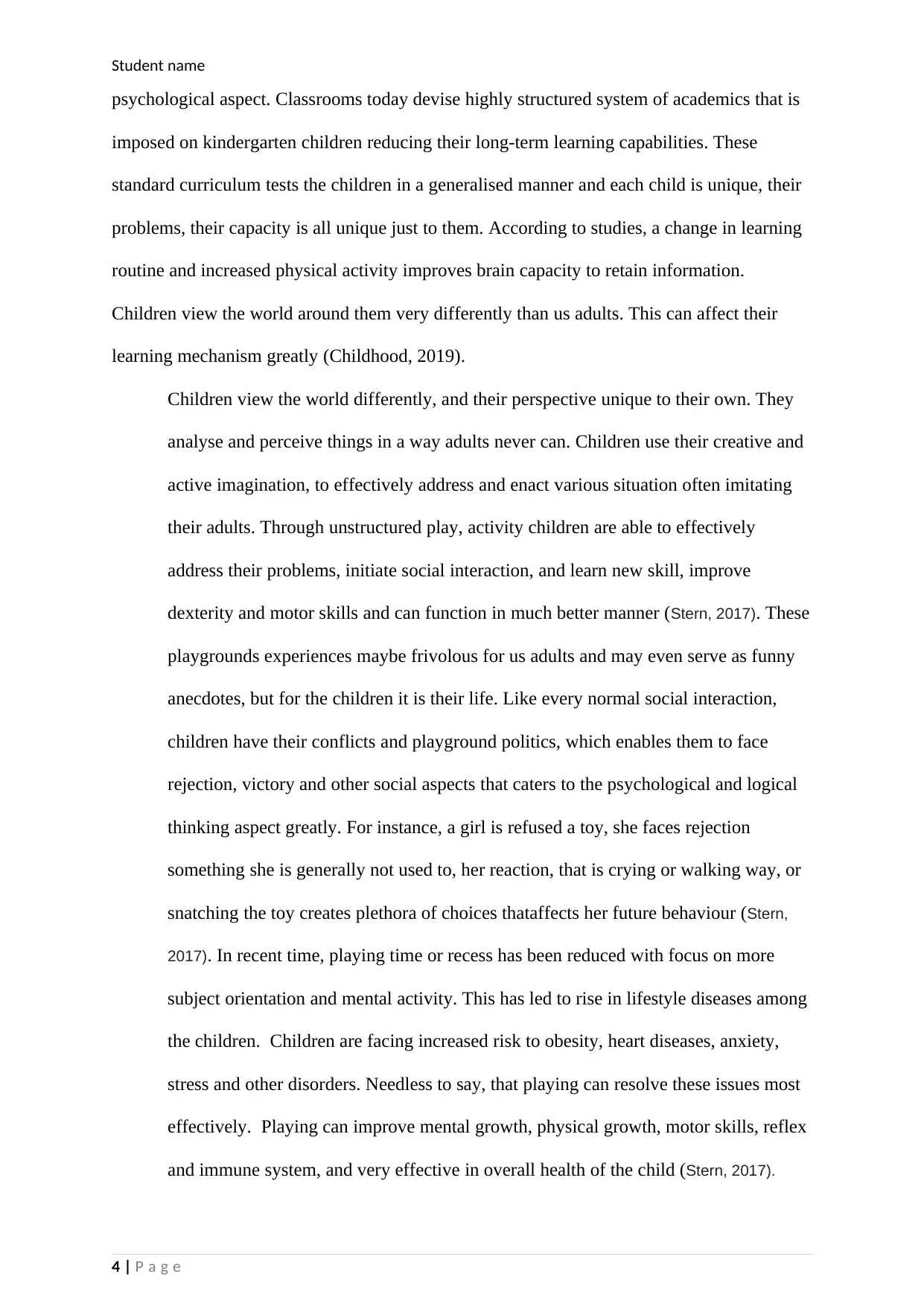
Student name
psychological aspect. Classrooms today devise highly structured system of academics that is
imposed on kindergarten children reducing their long-term learning capabilities. These
standard curriculum tests the children in a generalised manner and each child is unique, their
problems, their capacity is all unique just to them. According to studies, a change in learning
routine and increased physical activity improves brain capacity to retain information.
Children view the world around them very differently than us adults. This can affect their
learning mechanism greatly (Childhood, 2019).
Children view the world differently, and their perspective unique to their own. They
analyse and perceive things in a way adults never can. Children use their creative and
active imagination, to effectively address and enact various situation often imitating
their adults. Through unstructured play, activity children are able to effectively
address their problems, initiate social interaction, and learn new skill, improve
dexterity and motor skills and can function in much better manner (Stern, 2017). These
playgrounds experiences maybe frivolous for us adults and may even serve as funny
anecdotes, but for the children it is their life. Like every normal social interaction,
children have their conflicts and playground politics, which enables them to face
rejection, victory and other social aspects that caters to the psychological and logical
thinking aspect greatly. For instance, a girl is refused a toy, she faces rejection
something she is generally not used to, her reaction, that is crying or walking way, or
snatching the toy creates plethora of choices thataffects her future behaviour (Stern,
2017). In recent time, playing time or recess has been reduced with focus on more
subject orientation and mental activity. This has led to rise in lifestyle diseases among
the children. Children are facing increased risk to obesity, heart diseases, anxiety,
stress and other disorders. Needless to say, that playing can resolve these issues most
effectively. Playing can improve mental growth, physical growth, motor skills, reflex
and immune system, and very effective in overall health of the child (Stern, 2017).
4 | P a g e
psychological aspect. Classrooms today devise highly structured system of academics that is
imposed on kindergarten children reducing their long-term learning capabilities. These
standard curriculum tests the children in a generalised manner and each child is unique, their
problems, their capacity is all unique just to them. According to studies, a change in learning
routine and increased physical activity improves brain capacity to retain information.
Children view the world around them very differently than us adults. This can affect their
learning mechanism greatly (Childhood, 2019).
Children view the world differently, and their perspective unique to their own. They
analyse and perceive things in a way adults never can. Children use their creative and
active imagination, to effectively address and enact various situation often imitating
their adults. Through unstructured play, activity children are able to effectively
address their problems, initiate social interaction, and learn new skill, improve
dexterity and motor skills and can function in much better manner (Stern, 2017). These
playgrounds experiences maybe frivolous for us adults and may even serve as funny
anecdotes, but for the children it is their life. Like every normal social interaction,
children have their conflicts and playground politics, which enables them to face
rejection, victory and other social aspects that caters to the psychological and logical
thinking aspect greatly. For instance, a girl is refused a toy, she faces rejection
something she is generally not used to, her reaction, that is crying or walking way, or
snatching the toy creates plethora of choices thataffects her future behaviour (Stern,
2017). In recent time, playing time or recess has been reduced with focus on more
subject orientation and mental activity. This has led to rise in lifestyle diseases among
the children. Children are facing increased risk to obesity, heart diseases, anxiety,
stress and other disorders. Needless to say, that playing can resolve these issues most
effectively. Playing can improve mental growth, physical growth, motor skills, reflex
and immune system, and very effective in overall health of the child (Stern, 2017).
4 | P a g e
Paraphrase This Document
Need a fresh take? Get an instant paraphrase of this document with our AI Paraphraser
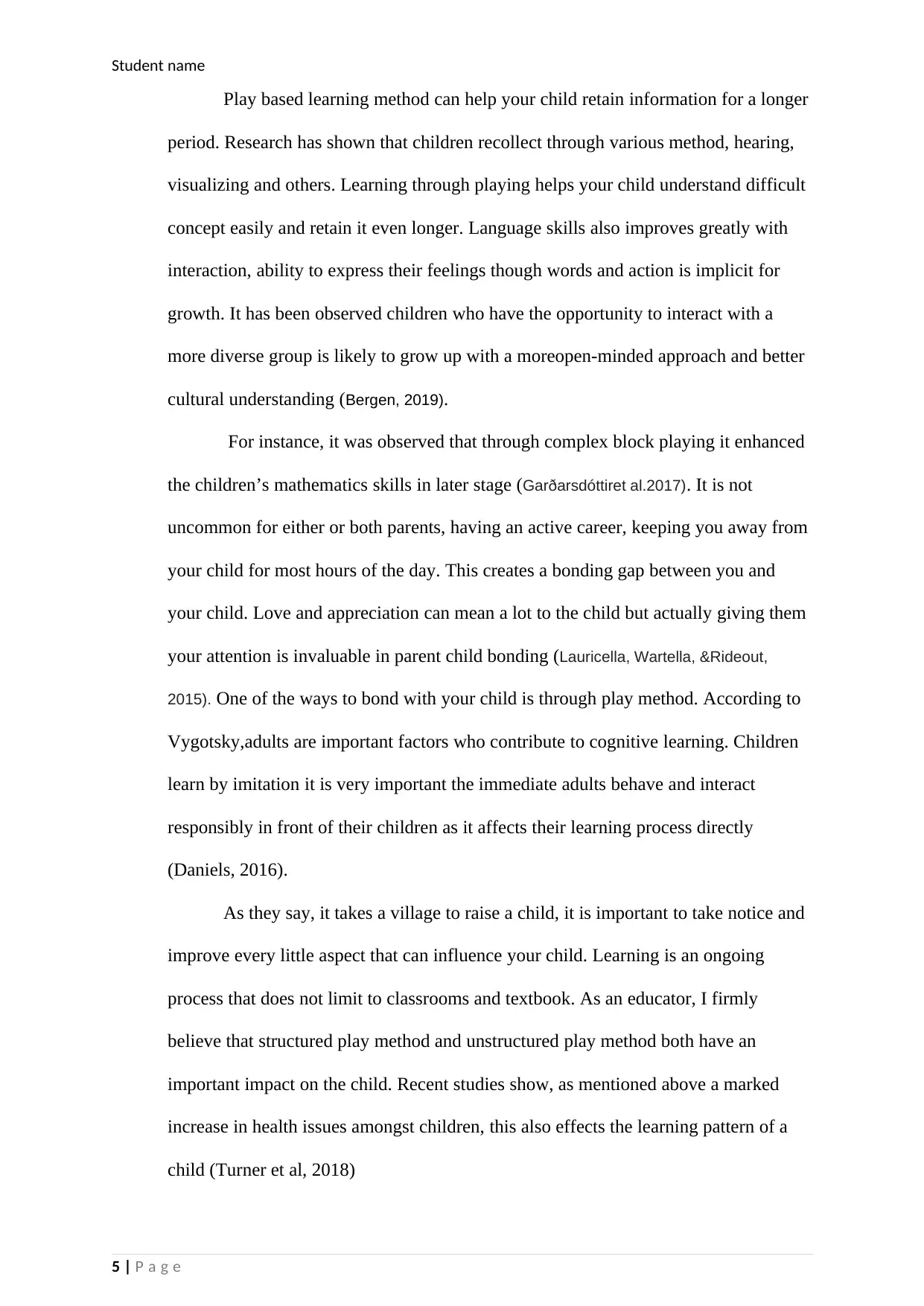
Student name
Play based learning method can help your child retain information for a longer
period. Research has shown that children recollect through various method, hearing,
visualizing and others. Learning through playing helps your child understand difficult
concept easily and retain it even longer. Language skills also improves greatly with
interaction, ability to express their feelings though words and action is implicit for
growth. It has been observed children who have the opportunity to interact with a
more diverse group is likely to grow up with a moreopen-minded approach and better
cultural understanding (Bergen, 2019).
For instance, it was observed that through complex block playing it enhanced
the children’s mathematics skills in later stage (Garðarsdóttiret al.2017). It is not
uncommon for either or both parents, having an active career, keeping you away from
your child for most hours of the day. This creates a bonding gap between you and
your child. Love and appreciation can mean a lot to the child but actually giving them
your attention is invaluable in parent child bonding (Lauricella, Wartella, &Rideout,
2015). One of the ways to bond with your child is through play method. According to
Vygotsky,adults are important factors who contribute to cognitive learning. Children
learn by imitation it is very important the immediate adults behave and interact
responsibly in front of their children as it affects their learning process directly
(Daniels, 2016).
As they say, it takes a village to raise a child, it is important to take notice and
improve every little aspect that can influence your child. Learning is an ongoing
process that does not limit to classrooms and textbook. As an educator, I firmly
believe that structured play method and unstructured play method both have an
important impact on the child. Recent studies show, as mentioned above a marked
increase in health issues amongst children, this also effects the learning pattern of a
child (Turner et al, 2018)
5 | P a g e
Play based learning method can help your child retain information for a longer
period. Research has shown that children recollect through various method, hearing,
visualizing and others. Learning through playing helps your child understand difficult
concept easily and retain it even longer. Language skills also improves greatly with
interaction, ability to express their feelings though words and action is implicit for
growth. It has been observed children who have the opportunity to interact with a
more diverse group is likely to grow up with a moreopen-minded approach and better
cultural understanding (Bergen, 2019).
For instance, it was observed that through complex block playing it enhanced
the children’s mathematics skills in later stage (Garðarsdóttiret al.2017). It is not
uncommon for either or both parents, having an active career, keeping you away from
your child for most hours of the day. This creates a bonding gap between you and
your child. Love and appreciation can mean a lot to the child but actually giving them
your attention is invaluable in parent child bonding (Lauricella, Wartella, &Rideout,
2015). One of the ways to bond with your child is through play method. According to
Vygotsky,adults are important factors who contribute to cognitive learning. Children
learn by imitation it is very important the immediate adults behave and interact
responsibly in front of their children as it affects their learning process directly
(Daniels, 2016).
As they say, it takes a village to raise a child, it is important to take notice and
improve every little aspect that can influence your child. Learning is an ongoing
process that does not limit to classrooms and textbook. As an educator, I firmly
believe that structured play method and unstructured play method both have an
important impact on the child. Recent studies show, as mentioned above a marked
increase in health issues amongst children, this also effects the learning pattern of a
child (Turner et al, 2018)
5 | P a g e
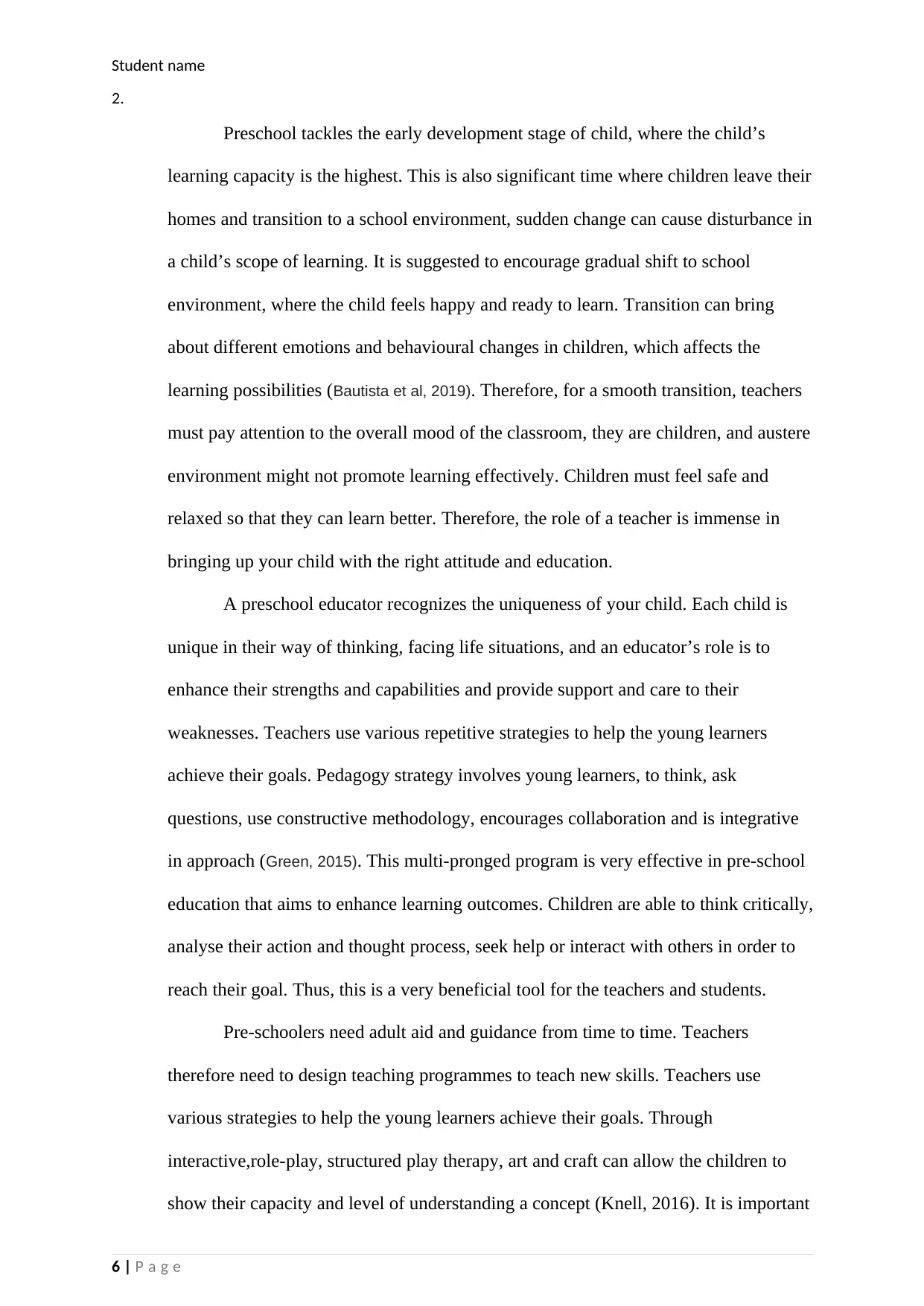
Student name
2.
Preschool tackles the early development stage of child, where the child’s
learning capacity is the highest. This is also significant time where children leave their
homes and transition to a school environment, sudden change can cause disturbance in
a child’s scope of learning. It is suggested to encourage gradual shift to school
environment, where the child feels happy and ready to learn. Transition can bring
about different emotions and behavioural changes in children, which affects the
learning possibilities (Bautista et al, 2019). Therefore, for a smooth transition, teachers
must pay attention to the overall mood of the classroom, they are children, and austere
environment might not promote learning effectively. Children must feel safe and
relaxed so that they can learn better. Therefore, the role of a teacher is immense in
bringing up your child with the right attitude and education.
A preschool educator recognizes the uniqueness of your child. Each child is
unique in their way of thinking, facing life situations, and an educator’s role is to
enhance their strengths and capabilities and provide support and care to their
weaknesses. Teachers use various repetitive strategies to help the young learners
achieve their goals. Pedagogy strategy involves young learners, to think, ask
questions, use constructive methodology, encourages collaboration and is integrative
in approach (Green, 2015). This multi-pronged program is very effective in pre-school
education that aims to enhance learning outcomes. Children are able to think critically,
analyse their action and thought process, seek help or interact with others in order to
reach their goal. Thus, this is a very beneficial tool for the teachers and students.
Pre-schoolers need adult aid and guidance from time to time. Teachers
therefore need to design teaching programmes to teach new skills. Teachers use
various strategies to help the young learners achieve their goals. Through
interactive,role-play, structured play therapy, art and craft can allow the children to
show their capacity and level of understanding a concept (Knell, 2016). It is important
6 | P a g e
2.
Preschool tackles the early development stage of child, where the child’s
learning capacity is the highest. This is also significant time where children leave their
homes and transition to a school environment, sudden change can cause disturbance in
a child’s scope of learning. It is suggested to encourage gradual shift to school
environment, where the child feels happy and ready to learn. Transition can bring
about different emotions and behavioural changes in children, which affects the
learning possibilities (Bautista et al, 2019). Therefore, for a smooth transition, teachers
must pay attention to the overall mood of the classroom, they are children, and austere
environment might not promote learning effectively. Children must feel safe and
relaxed so that they can learn better. Therefore, the role of a teacher is immense in
bringing up your child with the right attitude and education.
A preschool educator recognizes the uniqueness of your child. Each child is
unique in their way of thinking, facing life situations, and an educator’s role is to
enhance their strengths and capabilities and provide support and care to their
weaknesses. Teachers use various repetitive strategies to help the young learners
achieve their goals. Pedagogy strategy involves young learners, to think, ask
questions, use constructive methodology, encourages collaboration and is integrative
in approach (Green, 2015). This multi-pronged program is very effective in pre-school
education that aims to enhance learning outcomes. Children are able to think critically,
analyse their action and thought process, seek help or interact with others in order to
reach their goal. Thus, this is a very beneficial tool for the teachers and students.
Pre-schoolers need adult aid and guidance from time to time. Teachers
therefore need to design teaching programmes to teach new skills. Teachers use
various strategies to help the young learners achieve their goals. Through
interactive,role-play, structured play therapy, art and craft can allow the children to
show their capacity and level of understanding a concept (Knell, 2016). It is important
6 | P a g e
⊘ This is a preview!⊘
Do you want full access?
Subscribe today to unlock all pages.

Trusted by 1+ million students worldwide
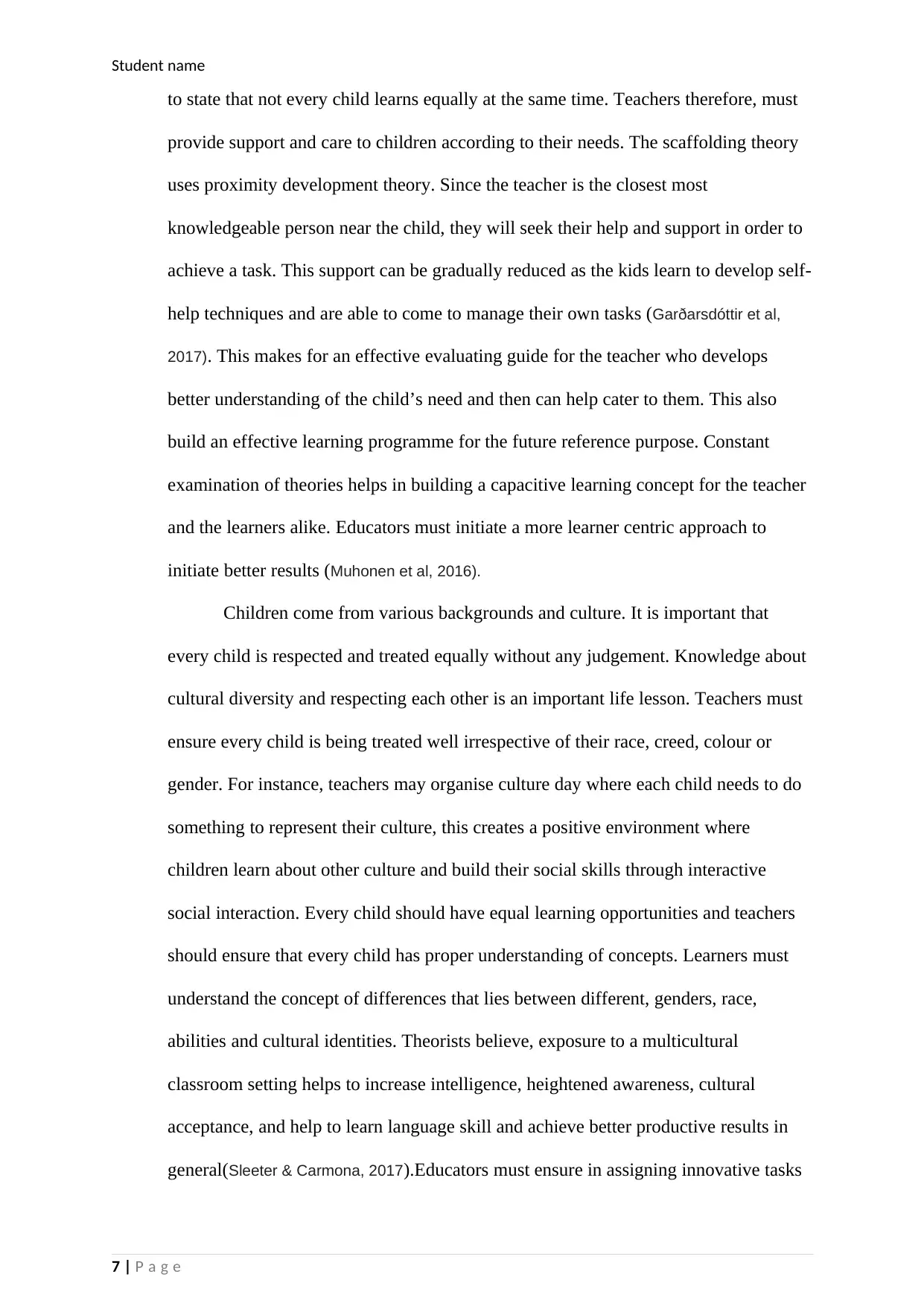
Student name
to state that not every child learns equally at the same time. Teachers therefore, must
provide support and care to children according to their needs. The scaffolding theory
uses proximity development theory. Since the teacher is the closest most
knowledgeable person near the child, they will seek their help and support in order to
achieve a task. This support can be gradually reduced as the kids learn to develop self-
help techniques and are able to come to manage their own tasks (Garðarsdóttir et al,
2017). This makes for an effective evaluating guide for the teacher who develops
better understanding of the child’s need and then can help cater to them. This also
build an effective learning programme for the future reference purpose. Constant
examination of theories helps in building a capacitive learning concept for the teacher
and the learners alike. Educators must initiate a more learner centric approach to
initiate better results (Muhonen et al, 2016).
Children come from various backgrounds and culture. It is important that
every child is respected and treated equally without any judgement. Knowledge about
cultural diversity and respecting each other is an important life lesson. Teachers must
ensure every child is being treated well irrespective of their race, creed, colour or
gender. For instance, teachers may organise culture day where each child needs to do
something to represent their culture, this creates a positive environment where
children learn about other culture and build their social skills through interactive
social interaction. Every child should have equal learning opportunities and teachers
should ensure that every child has proper understanding of concepts. Learners must
understand the concept of differences that lies between different, genders, race,
abilities and cultural identities. Theorists believe, exposure to a multicultural
classroom setting helps to increase intelligence, heightened awareness, cultural
acceptance, and help to learn language skill and achieve better productive results in
general(Sleeter & Carmona, 2017).Educators must ensure in assigning innovative tasks
7 | P a g e
to state that not every child learns equally at the same time. Teachers therefore, must
provide support and care to children according to their needs. The scaffolding theory
uses proximity development theory. Since the teacher is the closest most
knowledgeable person near the child, they will seek their help and support in order to
achieve a task. This support can be gradually reduced as the kids learn to develop self-
help techniques and are able to come to manage their own tasks (Garðarsdóttir et al,
2017). This makes for an effective evaluating guide for the teacher who develops
better understanding of the child’s need and then can help cater to them. This also
build an effective learning programme for the future reference purpose. Constant
examination of theories helps in building a capacitive learning concept for the teacher
and the learners alike. Educators must initiate a more learner centric approach to
initiate better results (Muhonen et al, 2016).
Children come from various backgrounds and culture. It is important that
every child is respected and treated equally without any judgement. Knowledge about
cultural diversity and respecting each other is an important life lesson. Teachers must
ensure every child is being treated well irrespective of their race, creed, colour or
gender. For instance, teachers may organise culture day where each child needs to do
something to represent their culture, this creates a positive environment where
children learn about other culture and build their social skills through interactive
social interaction. Every child should have equal learning opportunities and teachers
should ensure that every child has proper understanding of concepts. Learners must
understand the concept of differences that lies between different, genders, race,
abilities and cultural identities. Theorists believe, exposure to a multicultural
classroom setting helps to increase intelligence, heightened awareness, cultural
acceptance, and help to learn language skill and achieve better productive results in
general(Sleeter & Carmona, 2017).Educators must ensure in assigning innovative tasks
7 | P a g e
Paraphrase This Document
Need a fresh take? Get an instant paraphrase of this document with our AI Paraphraser
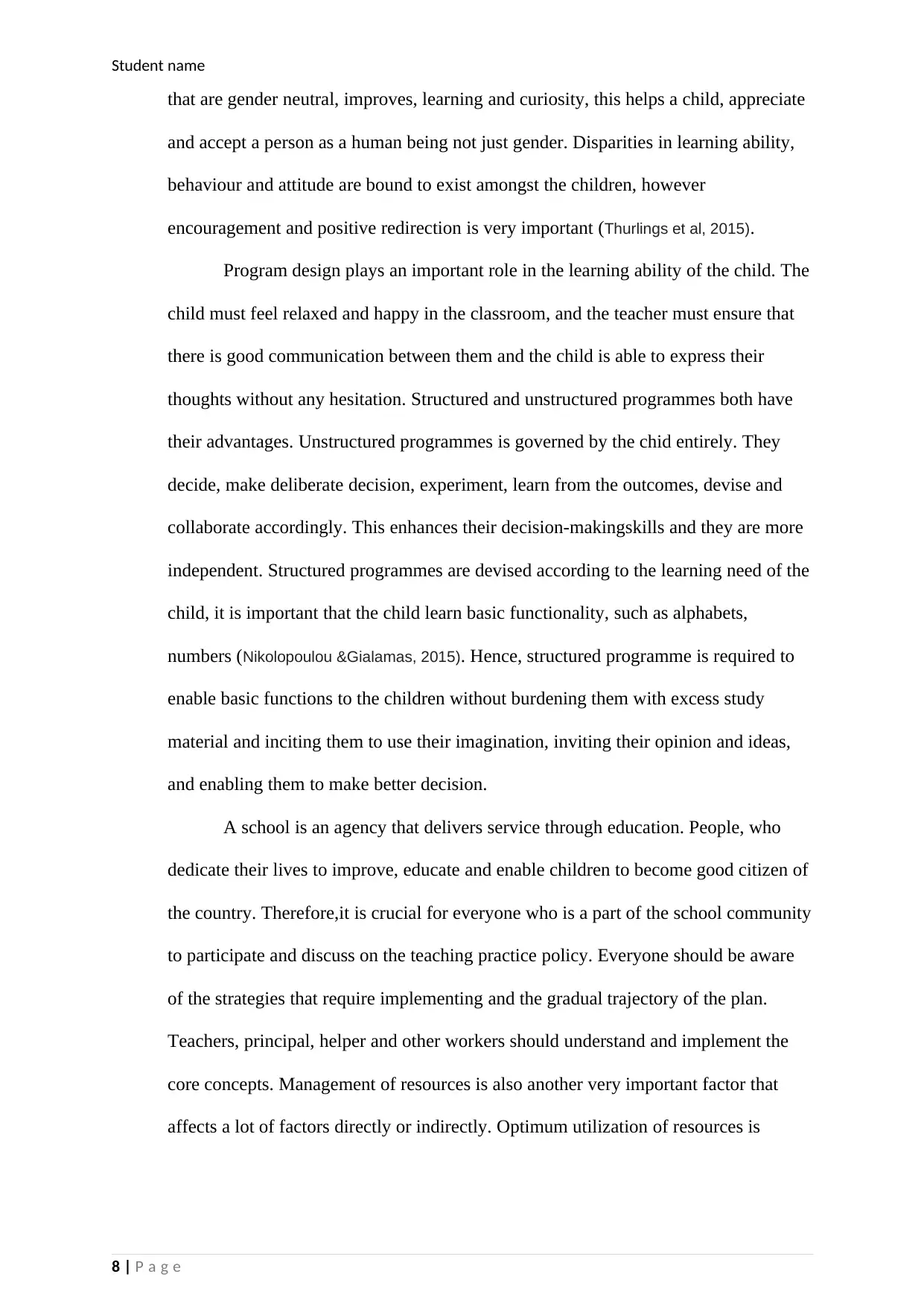
Student name
that are gender neutral, improves, learning and curiosity, this helps a child, appreciate
and accept a person as a human being not just gender. Disparities in learning ability,
behaviour and attitude are bound to exist amongst the children, however
encouragement and positive redirection is very important (Thurlings et al, 2015).
Program design plays an important role in the learning ability of the child. The
child must feel relaxed and happy in the classroom, and the teacher must ensure that
there is good communication between them and the child is able to express their
thoughts without any hesitation. Structured and unstructured programmes both have
their advantages. Unstructured programmes is governed by the chid entirely. They
decide, make deliberate decision, experiment, learn from the outcomes, devise and
collaborate accordingly. This enhances their decision-makingskills and they are more
independent. Structured programmes are devised according to the learning need of the
child, it is important that the child learn basic functionality, such as alphabets,
numbers (Nikolopoulou &Gialamas, 2015). Hence, structured programme is required to
enable basic functions to the children without burdening them with excess study
material and inciting them to use their imagination, inviting their opinion and ideas,
and enabling them to make better decision.
A school is an agency that delivers service through education. People, who
dedicate their lives to improve, educate and enable children to become good citizen of
the country. Therefore,it is crucial for everyone who is a part of the school community
to participate and discuss on the teaching practice policy. Everyone should be aware
of the strategies that require implementing and the gradual trajectory of the plan.
Teachers, principal, helper and other workers should understand and implement the
core concepts. Management of resources is also another very important factor that
affects a lot of factors directly or indirectly. Optimum utilization of resources is
8 | P a g e
that are gender neutral, improves, learning and curiosity, this helps a child, appreciate
and accept a person as a human being not just gender. Disparities in learning ability,
behaviour and attitude are bound to exist amongst the children, however
encouragement and positive redirection is very important (Thurlings et al, 2015).
Program design plays an important role in the learning ability of the child. The
child must feel relaxed and happy in the classroom, and the teacher must ensure that
there is good communication between them and the child is able to express their
thoughts without any hesitation. Structured and unstructured programmes both have
their advantages. Unstructured programmes is governed by the chid entirely. They
decide, make deliberate decision, experiment, learn from the outcomes, devise and
collaborate accordingly. This enhances their decision-makingskills and they are more
independent. Structured programmes are devised according to the learning need of the
child, it is important that the child learn basic functionality, such as alphabets,
numbers (Nikolopoulou &Gialamas, 2015). Hence, structured programme is required to
enable basic functions to the children without burdening them with excess study
material and inciting them to use their imagination, inviting their opinion and ideas,
and enabling them to make better decision.
A school is an agency that delivers service through education. People, who
dedicate their lives to improve, educate and enable children to become good citizen of
the country. Therefore,it is crucial for everyone who is a part of the school community
to participate and discuss on the teaching practice policy. Everyone should be aware
of the strategies that require implementing and the gradual trajectory of the plan.
Teachers, principal, helper and other workers should understand and implement the
core concepts. Management of resources is also another very important factor that
affects a lot of factors directly or indirectly. Optimum utilization of resources is
8 | P a g e
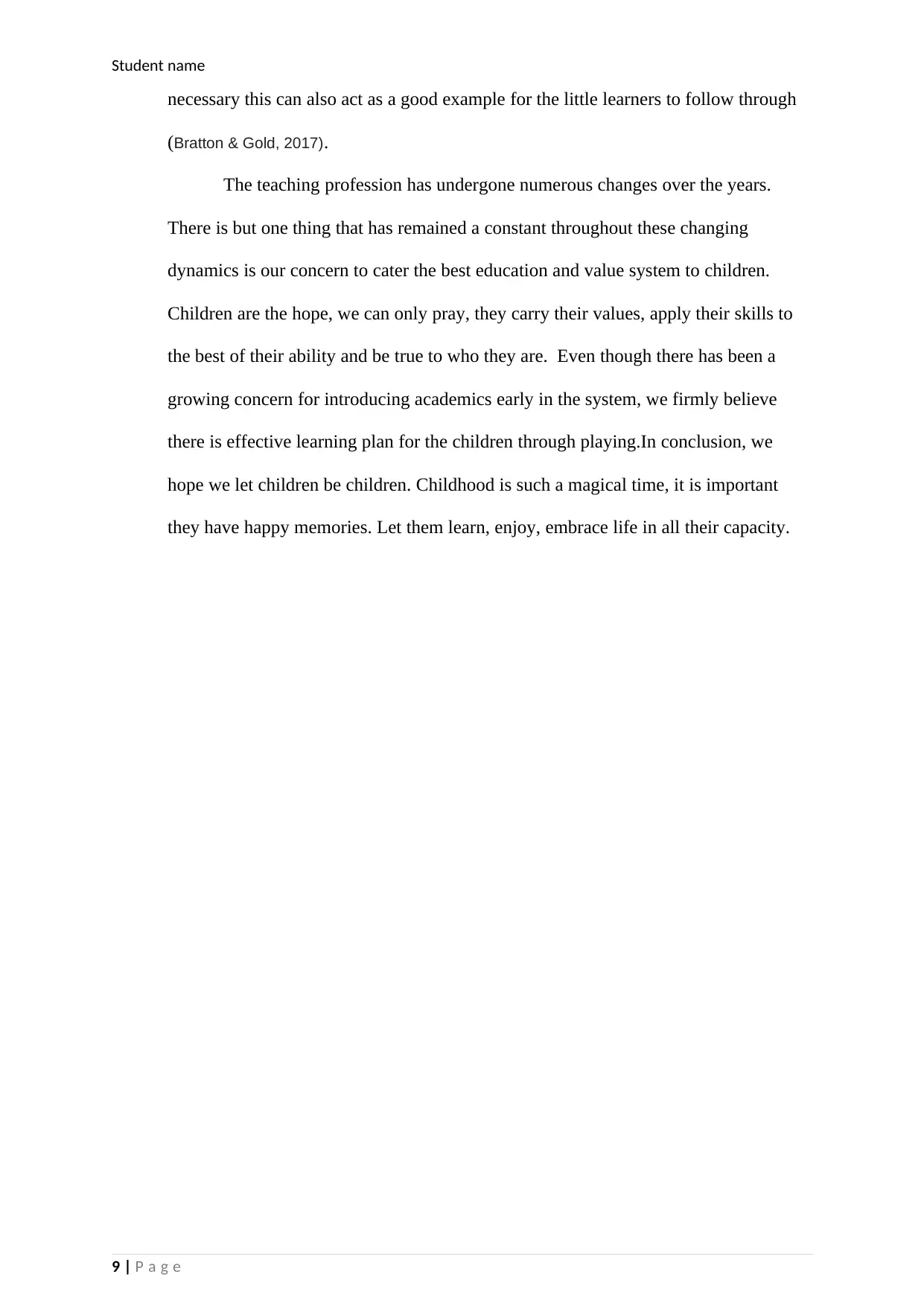
Student name
necessary this can also act as a good example for the little learners to follow through
(Bratton & Gold, 2017).
The teaching profession has undergone numerous changes over the years.
There is but one thing that has remained a constant throughout these changing
dynamics is our concern to cater the best education and value system to children.
Children are the hope, we can only pray, they carry their values, apply their skills to
the best of their ability and be true to who they are. Even though there has been a
growing concern for introducing academics early in the system, we firmly believe
there is effective learning plan for the children through playing.In conclusion, we
hope we let children be children. Childhood is such a magical time, it is important
they have happy memories. Let them learn, enjoy, embrace life in all their capacity.
9 | P a g e
necessary this can also act as a good example for the little learners to follow through
(Bratton & Gold, 2017).
The teaching profession has undergone numerous changes over the years.
There is but one thing that has remained a constant throughout these changing
dynamics is our concern to cater the best education and value system to children.
Children are the hope, we can only pray, they carry their values, apply their skills to
the best of their ability and be true to who they are. Even though there has been a
growing concern for introducing academics early in the system, we firmly believe
there is effective learning plan for the children through playing.In conclusion, we
hope we let children be children. Childhood is such a magical time, it is important
they have happy memories. Let them learn, enjoy, embrace life in all their capacity.
9 | P a g e
⊘ This is a preview!⊘
Do you want full access?
Subscribe today to unlock all pages.

Trusted by 1+ million students worldwide
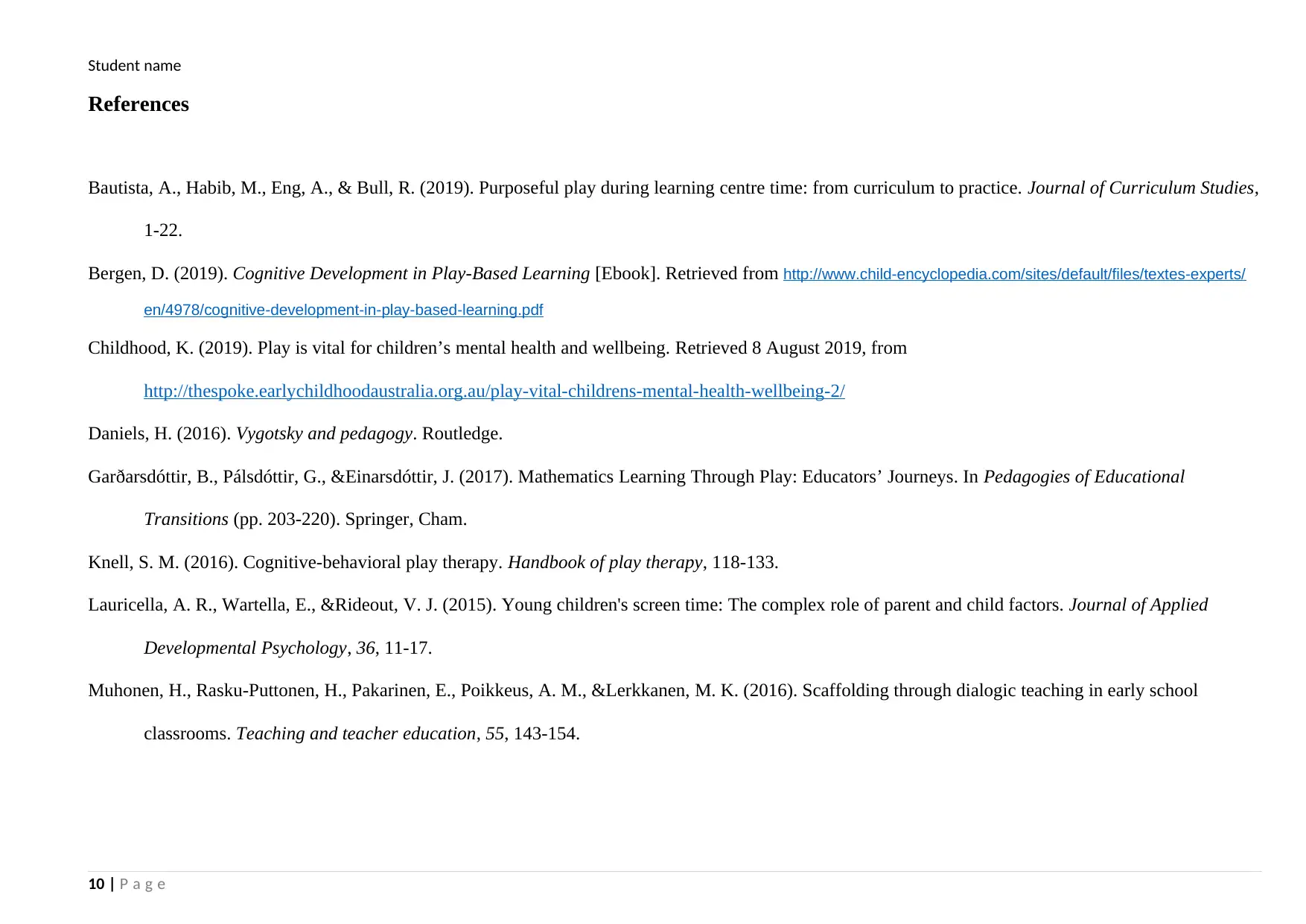
Student name
References
Bautista, A., Habib, M., Eng, A., & Bull, R. (2019). Purposeful play during learning centre time: from curriculum to practice. Journal of Curriculum Studies,
1-22.
Bergen, D. (2019). Cognitive Development in Play-Based Learning [Ebook]. Retrieved from http://www.child-encyclopedia.com/sites/default/files/textes-experts/
en/4978/cognitive-development-in-play-based-learning.pdf
Childhood, K. (2019). Play is vital for children’s mental health and wellbeing. Retrieved 8 August 2019, from
http://thespoke.earlychildhoodaustralia.org.au/play-vital-childrens-mental-health-wellbeing-2/
Daniels, H. (2016). Vygotsky and pedagogy. Routledge.
Garðarsdóttir, B., Pálsdóttir, G., &Einarsdóttir, J. (2017). Mathematics Learning Through Play: Educators’ Journeys. In Pedagogies of Educational
Transitions (pp. 203-220). Springer, Cham.
Knell, S. M. (2016). Cognitive-behavioral play therapy. Handbook of play therapy, 118-133.
Lauricella, A. R., Wartella, E., &Rideout, V. J. (2015). Young children's screen time: The complex role of parent and child factors. Journal of Applied
Developmental Psychology, 36, 11-17.
Muhonen, H., Rasku-Puttonen, H., Pakarinen, E., Poikkeus, A. M., &Lerkkanen, M. K. (2016). Scaffolding through dialogic teaching in early school
classrooms. Teaching and teacher education, 55, 143-154.
10 | P a g e
References
Bautista, A., Habib, M., Eng, A., & Bull, R. (2019). Purposeful play during learning centre time: from curriculum to practice. Journal of Curriculum Studies,
1-22.
Bergen, D. (2019). Cognitive Development in Play-Based Learning [Ebook]. Retrieved from http://www.child-encyclopedia.com/sites/default/files/textes-experts/
en/4978/cognitive-development-in-play-based-learning.pdf
Childhood, K. (2019). Play is vital for children’s mental health and wellbeing. Retrieved 8 August 2019, from
http://thespoke.earlychildhoodaustralia.org.au/play-vital-childrens-mental-health-wellbeing-2/
Daniels, H. (2016). Vygotsky and pedagogy. Routledge.
Garðarsdóttir, B., Pálsdóttir, G., &Einarsdóttir, J. (2017). Mathematics Learning Through Play: Educators’ Journeys. In Pedagogies of Educational
Transitions (pp. 203-220). Springer, Cham.
Knell, S. M. (2016). Cognitive-behavioral play therapy. Handbook of play therapy, 118-133.
Lauricella, A. R., Wartella, E., &Rideout, V. J. (2015). Young children's screen time: The complex role of parent and child factors. Journal of Applied
Developmental Psychology, 36, 11-17.
Muhonen, H., Rasku-Puttonen, H., Pakarinen, E., Poikkeus, A. M., &Lerkkanen, M. K. (2016). Scaffolding through dialogic teaching in early school
classrooms. Teaching and teacher education, 55, 143-154.
10 | P a g e
Paraphrase This Document
Need a fresh take? Get an instant paraphrase of this document with our AI Paraphraser
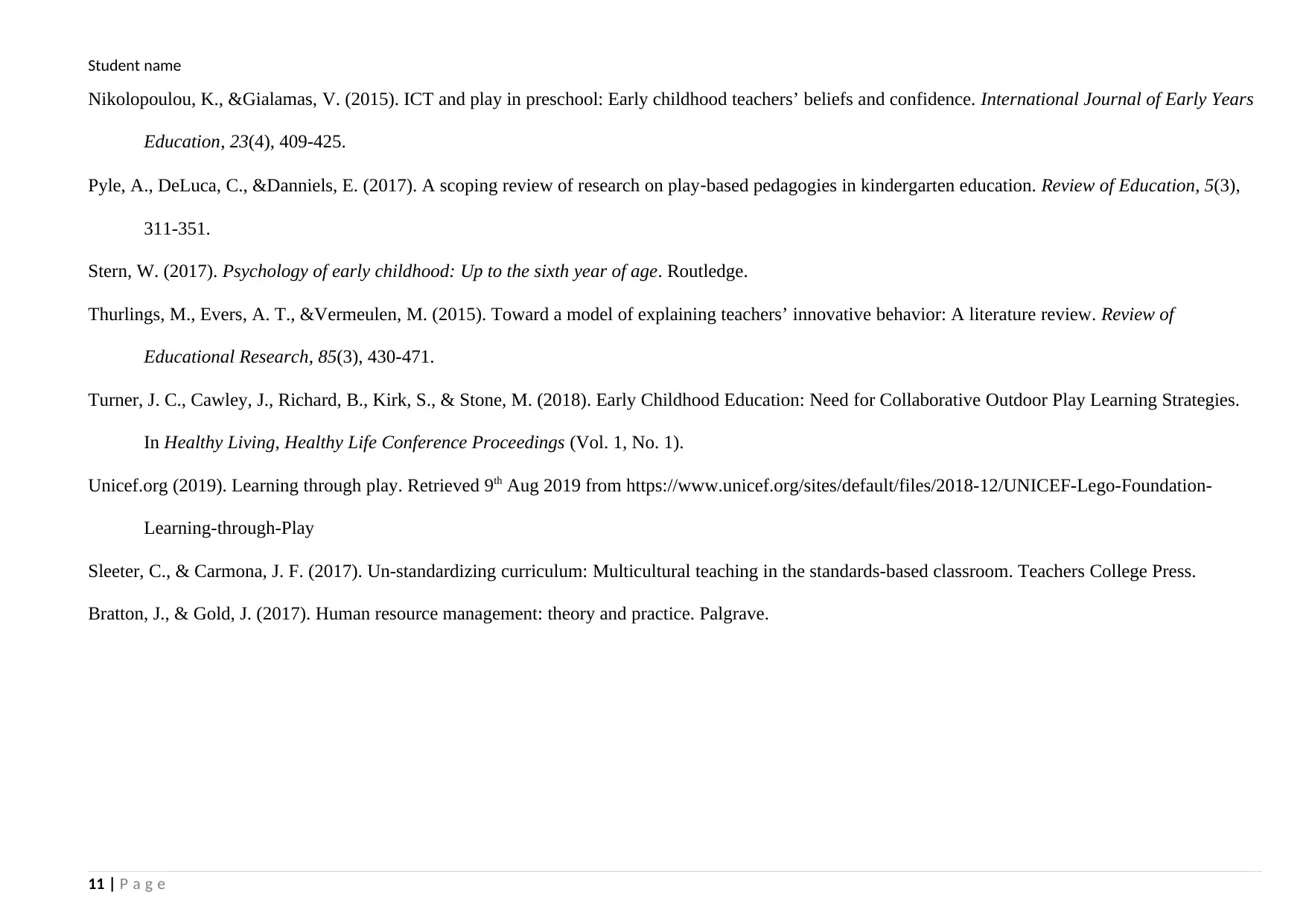
Student name
Nikolopoulou, K., &Gialamas, V. (2015). ICT and play in preschool: Early childhood teachers’ beliefs and confidence. International Journal of Early Years
Education, 23(4), 409-425.
Pyle, A., DeLuca, C., &Danniels, E. (2017). A scoping review of research on play‐based pedagogies in kindergarten education. Review of Education, 5(3),
311-351.
Stern, W. (2017). Psychology of early childhood: Up to the sixth year of age. Routledge.
Thurlings, M., Evers, A. T., &Vermeulen, M. (2015). Toward a model of explaining teachers’ innovative behavior: A literature review. Review of
Educational Research, 85(3), 430-471.
Turner, J. C., Cawley, J., Richard, B., Kirk, S., & Stone, M. (2018). Early Childhood Education: Need for Collaborative Outdoor Play Learning Strategies.
In Healthy Living, Healthy Life Conference Proceedings (Vol. 1, No. 1).
Unicef.org (2019). Learning through play. Retrieved 9th Aug 2019 from https://www.unicef.org/sites/default/files/2018-12/UNICEF-Lego-Foundation-
Learning-through-Play
Sleeter, C., & Carmona, J. F. (2017). Un-standardizing curriculum: Multicultural teaching in the standards-based classroom. Teachers College Press.
Bratton, J., & Gold, J. (2017). Human resource management: theory and practice. Palgrave.
11 | P a g e
Nikolopoulou, K., &Gialamas, V. (2015). ICT and play in preschool: Early childhood teachers’ beliefs and confidence. International Journal of Early Years
Education, 23(4), 409-425.
Pyle, A., DeLuca, C., &Danniels, E. (2017). A scoping review of research on play‐based pedagogies in kindergarten education. Review of Education, 5(3),
311-351.
Stern, W. (2017). Psychology of early childhood: Up to the sixth year of age. Routledge.
Thurlings, M., Evers, A. T., &Vermeulen, M. (2015). Toward a model of explaining teachers’ innovative behavior: A literature review. Review of
Educational Research, 85(3), 430-471.
Turner, J. C., Cawley, J., Richard, B., Kirk, S., & Stone, M. (2018). Early Childhood Education: Need for Collaborative Outdoor Play Learning Strategies.
In Healthy Living, Healthy Life Conference Proceedings (Vol. 1, No. 1).
Unicef.org (2019). Learning through play. Retrieved 9th Aug 2019 from https://www.unicef.org/sites/default/files/2018-12/UNICEF-Lego-Foundation-
Learning-through-Play
Sleeter, C., & Carmona, J. F. (2017). Un-standardizing curriculum: Multicultural teaching in the standards-based classroom. Teachers College Press.
Bratton, J., & Gold, J. (2017). Human resource management: theory and practice. Palgrave.
11 | P a g e
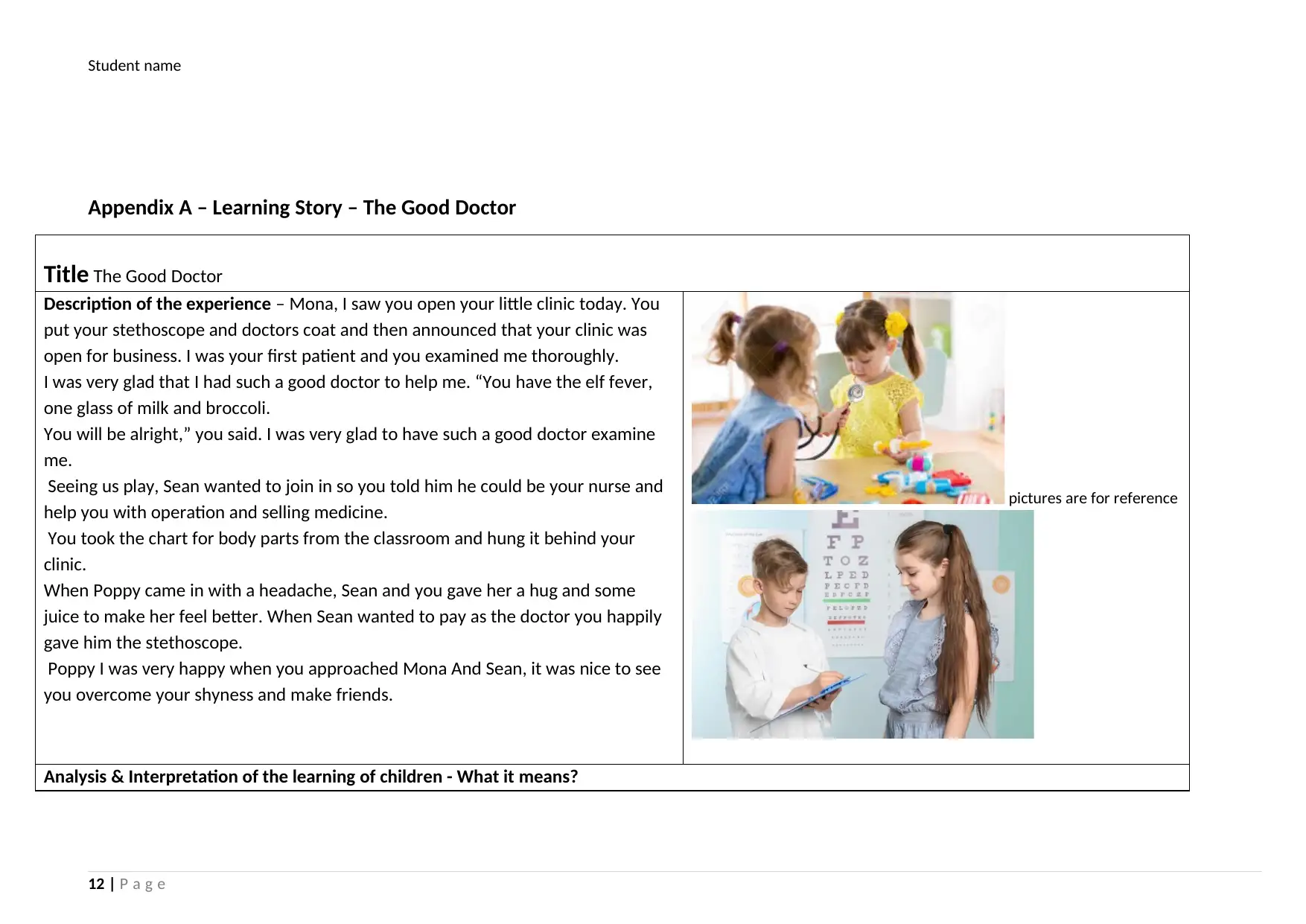
Student name
Appendix A – Learning Story – The Good Doctor
Title The Good Doctor
Description of the experience – Mona, I saw you open your little clinic today. You
put your stethoscope and doctors coat and then announced that your clinic was
open for business. I was your first patient and you examined me thoroughly.
I was very glad that I had such a good doctor to help me. “You have the elf fever,
one glass of milk and broccoli.
You will be alright,” you said. I was very glad to have such a good doctor examine
me.
Seeing us play, Sean wanted to join in so you told him he could be your nurse and
help you with operation and selling medicine.
You took the chart for body parts from the classroom and hung it behind your
clinic.
When Poppy came in with a headache, Sean and you gave her a hug and some
juice to make her feel better. When Sean wanted to pay as the doctor you happily
gave him the stethoscope.
Poppy I was very happy when you approached Mona And Sean, it was nice to see
you overcome your shyness and make friends.
pictures are for reference
Analysis & Interpretation of the learning of children - What it means?
12 | P a g e
Appendix A – Learning Story – The Good Doctor
Title The Good Doctor
Description of the experience – Mona, I saw you open your little clinic today. You
put your stethoscope and doctors coat and then announced that your clinic was
open for business. I was your first patient and you examined me thoroughly.
I was very glad that I had such a good doctor to help me. “You have the elf fever,
one glass of milk and broccoli.
You will be alright,” you said. I was very glad to have such a good doctor examine
me.
Seeing us play, Sean wanted to join in so you told him he could be your nurse and
help you with operation and selling medicine.
You took the chart for body parts from the classroom and hung it behind your
clinic.
When Poppy came in with a headache, Sean and you gave her a hug and some
juice to make her feel better. When Sean wanted to pay as the doctor you happily
gave him the stethoscope.
Poppy I was very happy when you approached Mona And Sean, it was nice to see
you overcome your shyness and make friends.
pictures are for reference
Analysis & Interpretation of the learning of children - What it means?
12 | P a g e
⊘ This is a preview!⊘
Do you want full access?
Subscribe today to unlock all pages.

Trusted by 1+ million students worldwide
1 out of 15
Related Documents
Your All-in-One AI-Powered Toolkit for Academic Success.
+13062052269
info@desklib.com
Available 24*7 on WhatsApp / Email
![[object Object]](/_next/static/media/star-bottom.7253800d.svg)
Unlock your academic potential
Copyright © 2020–2025 A2Z Services. All Rights Reserved. Developed and managed by ZUCOL.




